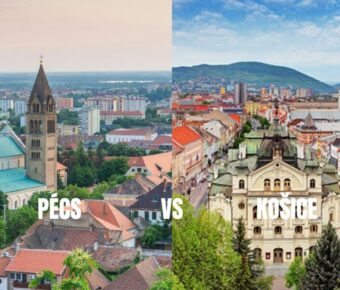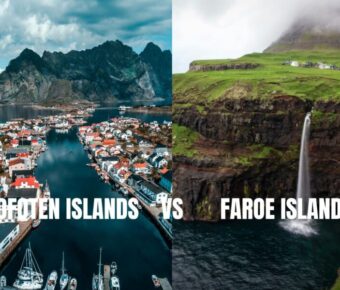
Ibiza vs Mykonos: 7 Surprising Differences for Your Dream Vacation
Picking between Ibiza and Mykonos? Trust me, it’s not as easy as booking the next cheap flight—it’s about figuring out what kind of escape you’re really after. If you want non-stop nightlife, Ibiza is the one, hands down. Mykonos, though, is all about chic beach clubs and those classy, sun-drenched evenings. Both islands serve up sun, sea, and good times, but wow, the energy is worlds apart.
I’ve lost track of how many summers I’ve spent bouncing between these two. The difference always hits me right away. Ibiza has this wild, electric pulse—mega clubs keep the music thumping until the sun’s up. Mykonos? It’s got this glossy, boutique vibe. Picture cobblestone lanes, long lunches by the water, and a sense of style that feels effortless. Both are gorgeous, but which one feels right for you totally depends on your mood.
Table of Contents
- Key Takeaways
- Ibiza vs Mykonos: Key Differences at a Glance
- Island Size and Location
- Travel Accessibility
- Overall Vibe and Atmosphere
- Nightlife and Party Scene
- Famous Clubs and DJs
- Unique Party Experiences
- Celebrity Sightings
- Beach Clubs and Sun-Kissed Shores
- Top Beaches in Ibiza
- Top Beaches in Mykonos
- Beach Club Culture
- Culture, Architecture, and Local Charm
- Cycladic Architecture in Mykonos
- Historic Sights in Ibiza
- Charming Towns and Villages
- Culinary Experiences and Local Flavors
- Traditional Greek Cuisine
- Spanish Tapas and Paella
- Trendy Seafront Dining
- Tourist Attractions and Unique Activities
- Iconic Landmarks
- Shopping and Markets
- Wellness and Outdoor Adventures
- Frequently Asked Questions
- What are the main differences in nightlife between Ibiza and Mykonos?
- Which destination, Ibiza or Mykonos, offers a more luxurious travel experience?
- How do the cultural attractions of Ibiza compare with those of Mykonos?
- Can you explore Mykonos beyond its party scene?
- What distinguishes the beaches of Mykonos from those in Ibiza?
- In terms of dining experiences, how do Ibiza and Mykonos differ?
- Book Your Dream Experience
- More Travel Guides
Key Takeaways
- Ibiza crackles with high-energy nightlife and endless party choices
- Mykonos brings you upscale beach clubs and a more refined, stylish mood
- Sun, culture, and food? You’ll get them both, but each island has its own flavor
Ibiza vs Mykonos: Key Differences at a Glance
Sure, both are famous for beaches, parties, and a taste of luxury, but step onto either island and you’ll notice the differences right away. Ibiza is bigger, more spread out, and part of Spain’s Balearic Islands. Mykonos? It’s smaller, tighter, and easily one of Greece’s most iconic Cycladic gems.
Island Size and Location
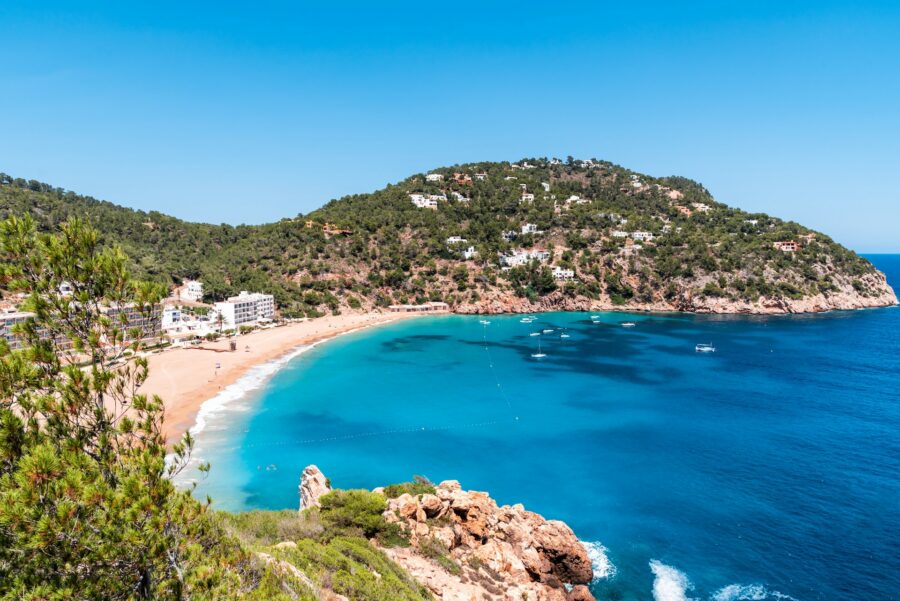
Ibiza hangs out in Spain’s Balearic Islands, stretching across about 221 square miles. That’s over six times the size of Mykonos, which is a compact 33 square miles. The size really changes how you get around.
You’ll probably rent a car in Ibiza, just to reach those hidden coves or sleepy inland villages. The island’s middle is full of farmland, pine woods, and quiet escapes that feel a world away from the beach party scene.
Mykonos? Everything feels close. The main town, Chora, is perfect for wandering—narrow lanes, whitewashed houses, and everything clustered together. Beaches and towns are just a quick hop apart, so you can see a lot without much effort.
If you love variety and room to roam, Ibiza’s your playground. Prefer an island where you can bounce from beach to club in minutes? Mykonos makes it easy.
Travel Accessibility
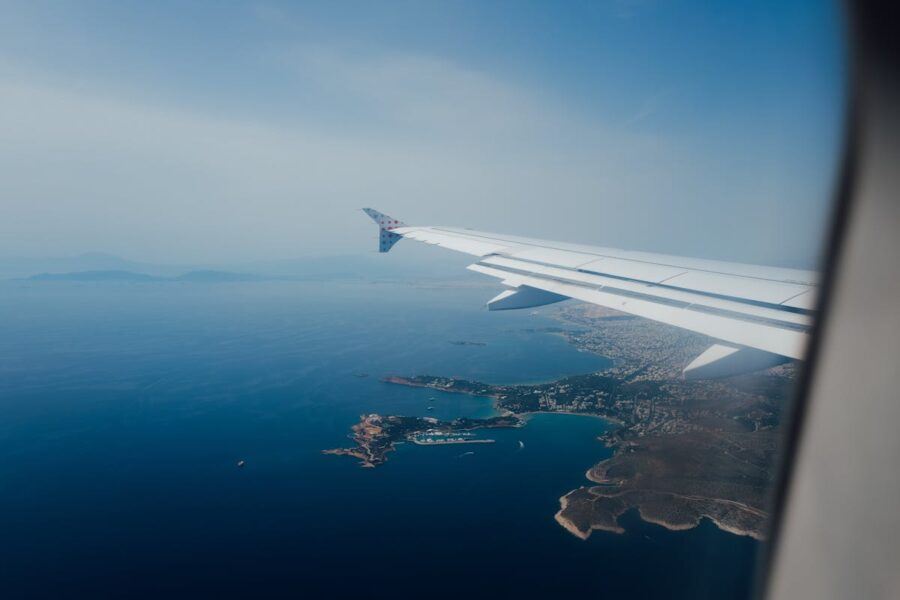
Summer flights hit both islands in droves, but Ibiza is just easier to reach from all over Europe. The airport connects daily to tons of cities, and ferries zip over from the other Balearics. If you’re already in Spain, it’s a breeze.
Mykonos has direct flights too, but not as many as Ibiza. Most people end up connecting through Athens, or they take a ferry (which, let’s be honest, can be a bit of a trek).
If you’re looking for bargains, start hunting for cheap flights early—summer prices jump fast. Booking.com is full of options for stays and transport, but July and August? Book way ahead.
So yeah, Ibiza wins for convenience and flight choices. Mykonos just takes a little more planning, but hey, sometimes that’s half the fun.
Overall Vibe and Atmosphere
Ibiza’s reputation as a party island is legendary, but it’s not all neon and bass drops. The north is surprisingly chill, with yoga spots and farm-to-table restaurants. One day you might rave until sunrise, the next you’re eating paella in a sleepy village.
Mykonos leans hard into glamour and exclusivity. The beach clubs feel like fashion runways, with champagne on tap and designer shops a flip-flop away. Since it’s smaller, that luxury vibe is concentrated—especially in Chora and those southern beaches.
Looking for a mix of party, culture, and a bit of nature? Ibiza’s got the balance. If you’re all about chic nightlife, high-end shopping, and that polished Greek vibe, Mykonos might just steal your heart.
Nightlife and Party Scene
Ibiza and Mykonos both live up to the hype when it comes to nightlife, but they each have their own personality. Ibiza is all about massive electronic music events that go until the sun’s up. Mykonos? It’s this blend of high-energy clubs and stylish beach spots that just ooze glam.
Famous Clubs and DJs
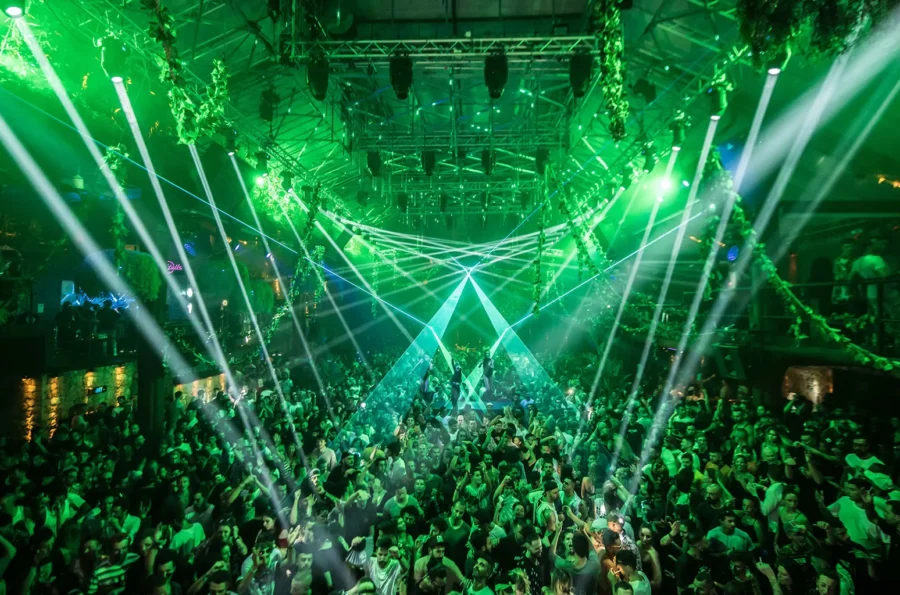
If electronic music is your thing, Ibiza is pretty unbeatable. Pacha, Amnesia, Ushuaïa—these aren’t just clubs, they’re legends. Think world-famous DJs like David Guetta and Carl Cox, light shows that feel like mini-festivals, and crowds that go wild.
Mykonos brings its own heavyweights, just on a more intimate scale. Cavo Paradiso sits on a cliff, and when the sun rises over the sea, the party just keeps rolling. You’ve got Scorpios and Nammos too, where music, fine dining, and champagne all blend together.
Ibiza is the king of all-night raves and big-room energy. Mykonos? It’s more about polished, social clubbing by the sea. If you want to feel like you’re at the heart of the global dance scene, Ibiza’s your stage. Prefer something a little more refined? Mykonos nails it.
Unique Party Experiences
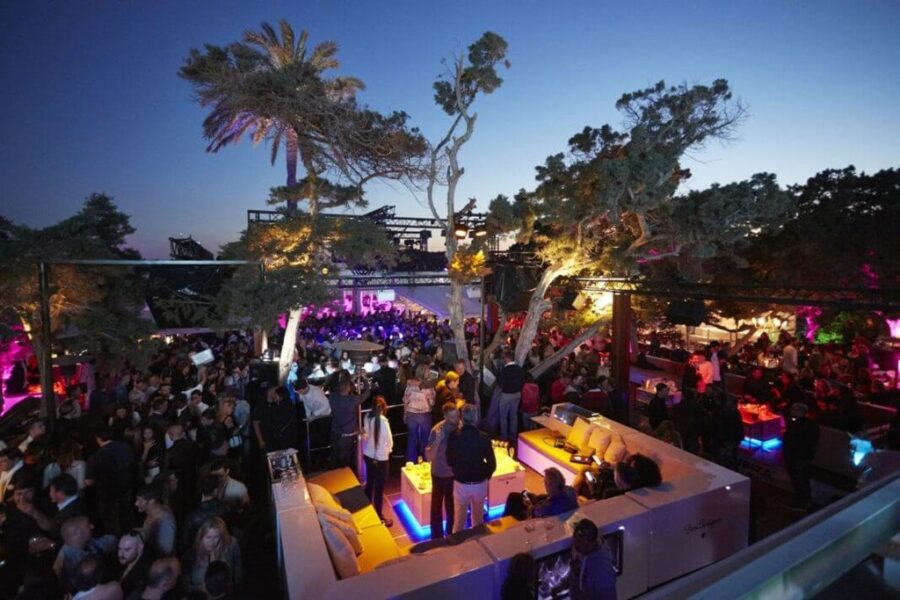
After hopping between both, I can tell you the vibe outside the main clubs is totally different. In Ibiza, the party spills over into places like Blue Marlin—start with a sunbed, end up dancing under the stars, no big deal. And don’t even get me started on the boat parties, with DJs spinning as you cruise the Balearics.
Mykonos likes to ease you from day to night. Maybe you kick things off with cocktails at Nikki Beach, catch the sunset at Scorpios, and end up grooving by the water at Cavo Paradiso. It’s energetic, but somehow more relaxed.
To me, Ibiza’s about intensity and scale, while Mykonos weaves nightlife into an all-day lifestyle. You’re not just clubbing—you’re eating, sunning, and mingling, all without missing a beat.
Celebrity Sightings
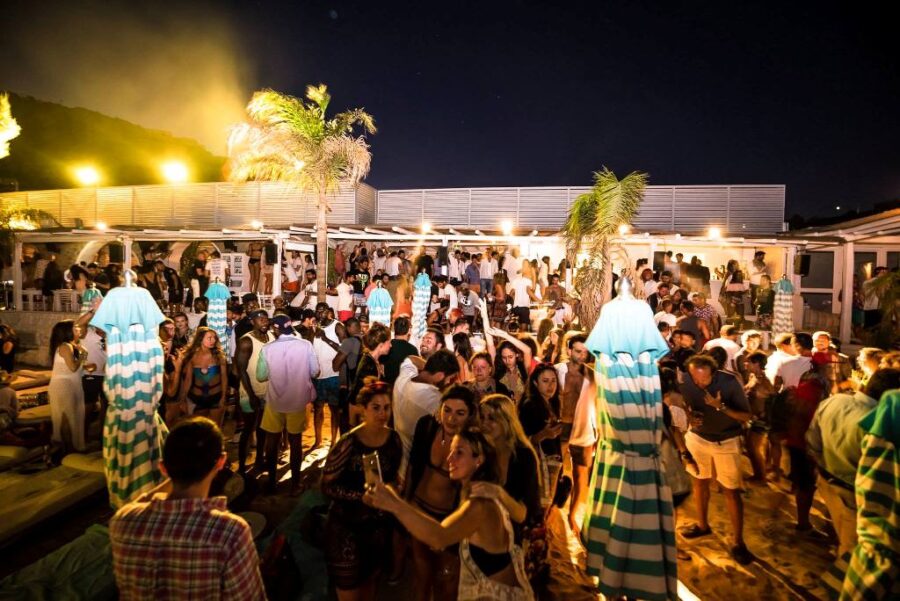
You’ll spot celebrities on both islands, but the scene feels different. Ibiza draws global DJs and A-listers who just want to blend in at Pacha or Ushuaïa. The music’s the focus, so even the biggest stars seem to disappear into the crowd.
Mykonos, though, feels like a catwalk for celebrity culture. Nammos and Scorpios are magnets for actors, models, and athletes. I once watched a famous footballer dance barefoot at Nammos—nobody blinked. That’s just Mykonos for you.
If rubbing shoulders with DJs and dance music royalty sounds fun, Ibiza is the place. Prefer people-watching with a glass of rosé while celebs stroll by? Mykonos delivers.
Want a deeper dive into nightlife differences? Here’s a great Ibiza vs Mykonos nightlife breakdown.
Beach Clubs and Sun-Kissed Shores
Crystal water, soft sand, and a beach culture that’s half lazy afternoons, half wild parties—both islands have it dialed in. Some stretches are pure chill, others are all about the music and cocktails.
Top Beaches in Ibiza
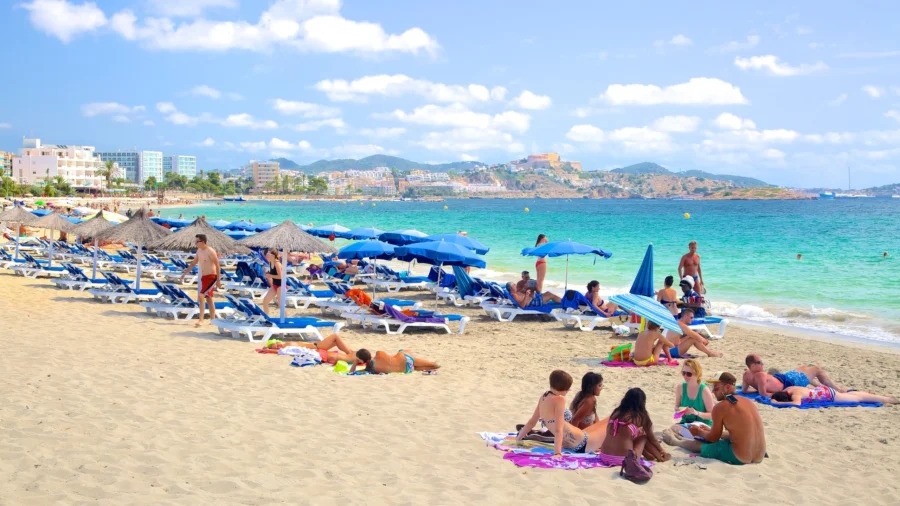
In Ibiza, your mood decides your beach. Playa d’en Bossa is the go-to for action—bars, DJs, water sports, and barely a quiet moment. Want something mellow? Cala d’Hort gives you epic views of Es Vedrà, especially at sunset. It’s got this mystical vibe that’s hard to describe.
Benirràs Beach is another gem, especially on Sundays with those drumming sessions. There’s a boho, spiritual feel, and honestly, you’ll lose track of time there.
For a real change of pace, hop a quick ferry to Formentera. The beaches—like Ses Illetes—are so clear and shallow, people compare them to the Caribbean. Pack a picnic or rent a bike; it’s peaceful, slow, and nothing like Ibiza’s party side.
Top Beaches in Mykonos
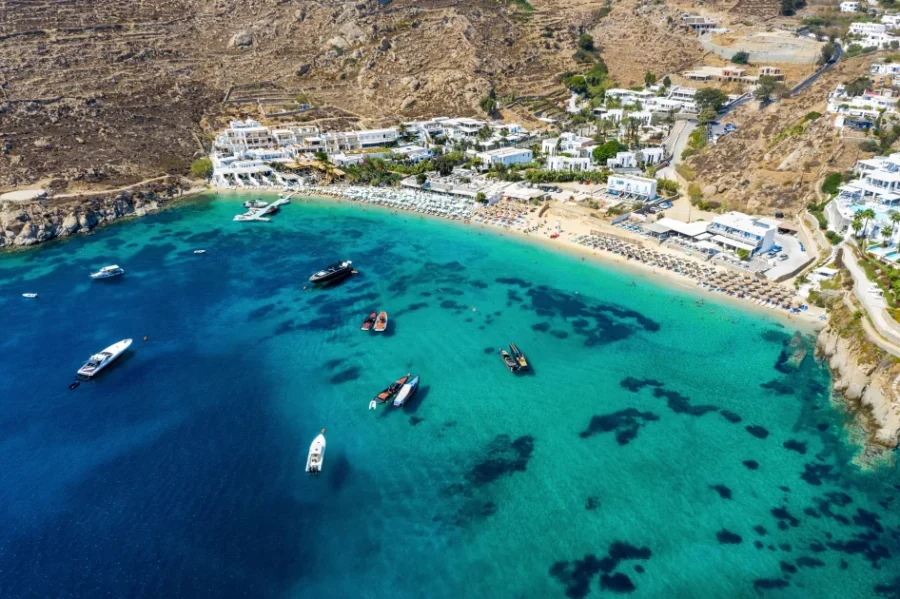
Mykonos beaches are all about style. Psarou Beach is the classic scene—designer shades, yachts, and the occasional celebrity. It’s pricey, but if you want that glossy vibe, it’s the spot.
For real party energy, Paradise Beach and Super Paradise kick off in the afternoon and don’t quit until sunrise. The music is right on the sand, and you’ll get swept up whether you mean to or not.
Then there’s Agios Sostis—the total opposite. No sunbeds, no booming music, just golden sand and a tiny taverna grilling seafood. I always tell people to check it out if they want to see the quieter, more authentic side of Mykonos.
Beach Club Culture

Honestly, the beach clubs are half the fun. Ibiza’s Blue Marlin and Nikki Beach mix food, cocktails, and DJs with a vibe that’s somehow both chill and lively. You could easily spend all day there—eat, swim, catch the sunset, then dance until late.
Mykonos clubs feel a bit more curated. Scorpios is the talk of the island—earthy design, sunset rituals, and a crowd that looks straight off Instagram. Cavo Paradiso sits high above the sea; it’s a nightclub with a killer view.
If you’re torn between the two, here’s the thing: Ibiza is spontaneous, where the party might just move onto the sand without warning. Mykonos feels more staged and exclusive. Both are a blast, but your choice depends on whether you want free-spirited fun or a finely tuned scene.
Want to compare even more? Check out this guide on Ibiza vs Mykonos beaches and nightlife.
Culture, Architecture, and Local Charm
Each island pulses with its own identity. You’ll see it in the buildings, feel it in the history, and—if you’re lucky—get swept up in the way locals bring their towns to life.
Cycladic Architecture in Mykonos

Think Greek islands and you probably picture Mykonos Town’s whitewashed houses. The Cycladic architecture is iconic—flat roofs, cubic shapes, and those blue shutters that just pop in the sunlight. It’s simple, but it never goes out of style.
The streets twist and turn in a way that’s almost dizzying. That’s no accident—the maze-like design was meant to confuse pirates, so every stroll feels a bit like an adventure.
Little Venice is one of those spots you can’t miss. Colorful balconies hang right over the water. I once sat there for hours at sunset, just watching waves slap the stone walls. Sometimes the best thing to do is nothing at all.
If you’re into history, hop a boat to Delos. It’s uninhabited now, but once was a major religious center in ancient Greece. The contrast to Mykonos’ nightlife is wild, but it really shows how deep the island’s roots go.
Historic Sights in Ibiza

Ibiza isn’t just about clubs and DJs—there’s a whole world of history layered on this island if you know where to look. Especially in Dalt Vila, the old fortified town, you’ll find cobbled streets winding up to a cathedral, and the views over the harbor? Absolutely worth the climb.
I once wandered those streets at sunrise, before the shops even thought about opening. It genuinely felt like time had hit pause. The Renaissance-era walls still stand strong, and you can stroll along parts of them for a fresh angle on the city.
Ibiza’s got a more visible past than Mykonos, in my opinion, with Romans, Moors, and Catalans all leaving their fingerprints behind. Even the little things—those worn wooden doors, the heavy stone arches—whisper stories of centuries gone by.
Inside Dalt Vila, museums showcase artifacts from all those eras. But honestly? Sometimes just sipping coffee at a café in the square and watching the world go by will tell you all you need to know about how old and new mix here.
Charming Towns and Villages
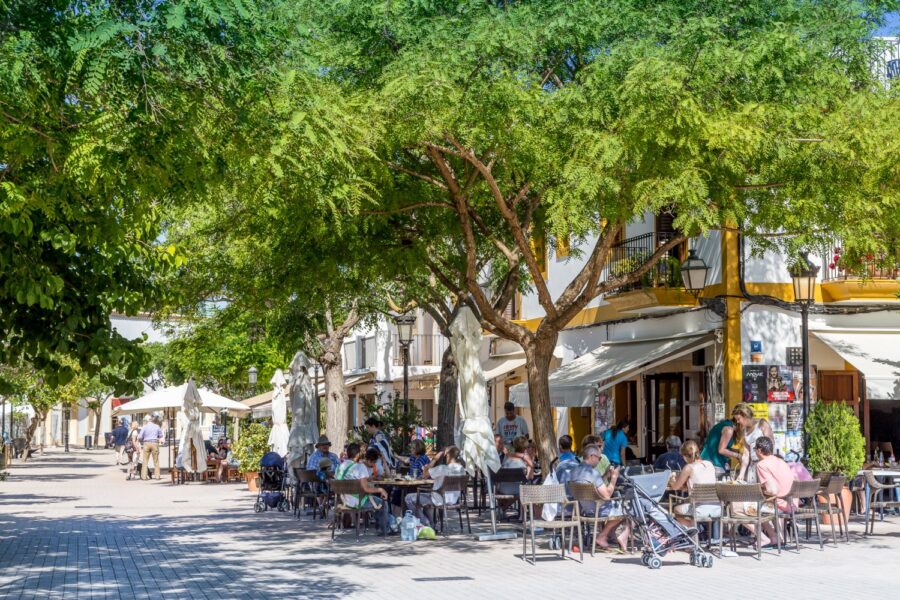
Let’s step away from the main towns for a second. Both islands have smaller villages that offer something totally different. In Mykonos, places like Ano Mera are quiet and genuinely traditional. There’s a central square, a monastery, and tavernas where locals gather. Nightlife feels a million miles away here.
Ibiza’s villages are just as charming. Take Santa Gertrudis—it’s got a mellow pace, whitewashed houses, and a church right in the middle. Artists and expats love it, so you’ll spot galleries tucked between old-school tapas bars.
If you can, rent a car and go exploring on your own schedule. I always tell friends to do this. You get a breather from the crowds, and honestly, some of my best meals and conversations happened in these overlooked corners.
These villages might not have blockbuster attractions, but they’re where you’ll stumble on the real island life. Maybe it’s a Sunday market, a bakery run by the same family for generations, or a square where kids play and parents linger over coffee.
Culinary Experiences and Local Flavors
Food shapes your trip as much as the beaches or the nightlife. Meals here aren’t just about filling up—they’re about slowing down, sharing, and soaking up the island’s vibe. Both islands bring their own flavors, from rustic family recipes to modern plates served with a sea view.
Traditional Greek Cuisine

In Mykonos, you’ll feel like you’ve joined a big Greek family at the table. The tavernas serve up hearty souvlaki—grilled meats on skewers, simple but so satisfying. Pair that with a Greek salad loaded with feta, and you’ve got a classic lunch locals swear by.
Seafood shines here too. Grilled octopus with lemon and olive oil tastes like it just came from the Aegean. And don’t skip the moussaka—layers of eggplant, minced meat, and béchamel, baked to perfection. It’s Greek comfort food at its best.
What I really appreciate about eating in Mykonos is how even the upscale spots stick to their roots. Sure, you’ll spot some international twists, but the soul of the food always circles back to those family recipes.
Spanish Tapas and Paella
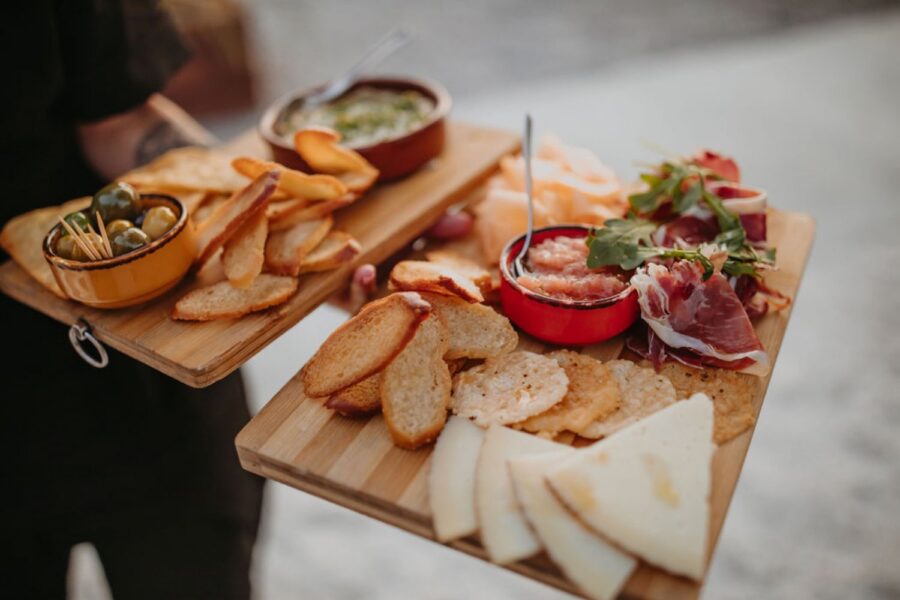
Ibiza, meanwhile, is all about variety and sharing plates. You’ll bump into tapas everywhere—from beach bars to swanky restaurants in Ibiza Town. Picture patatas bravas, garlic shrimp, jamón ibérico… It’s fun to order a bunch and just sample your way through.
And then there’s paella. Ibiza’s coastal setting means seafood paella is a staple—prawns, clams, mussels, all nestled in saffron rice. It usually comes in a big pan for the whole table, so it feels more like a celebration than just dinner.
I’ll never forget sitting at a beachside place in Santa Eulalia, digging into paella as the sun set. Nothing fancy, but somehow it felt like the most “Ibiza” thing ever—good food, salty air, and that relaxed Mediterranean pace.
Trendy Seafront Dining
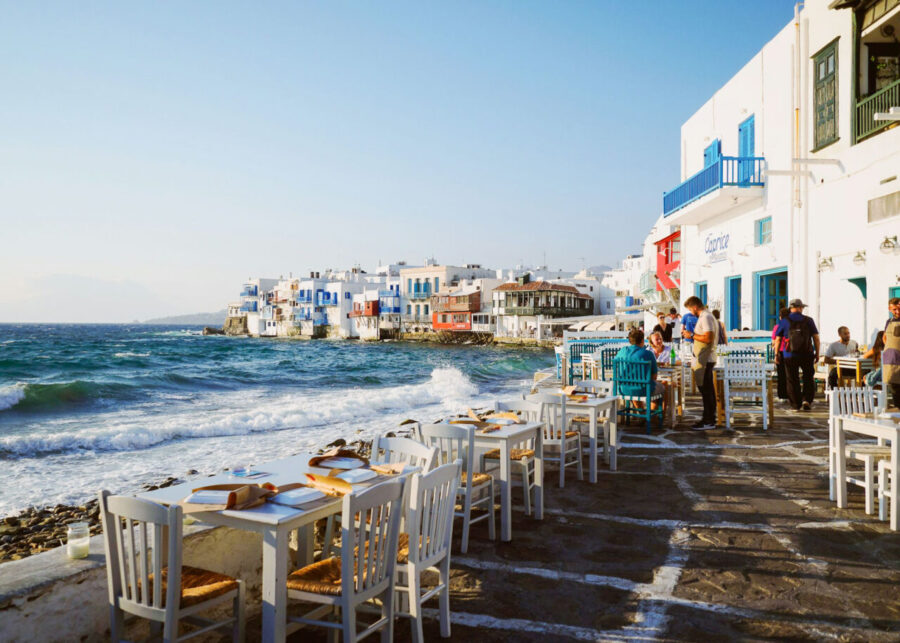
Both islands love their food-with-a-view moments. In Mykonos, you’ll find sleek restaurants perched over the water in Little Venice. Expect cocktails, maybe a DJ, and definitely some people-watching alongside your meal. It’s not about cheap eats here; it’s about the vibe.
Ibiza’s got a similar energy along Playa d’en Bossa and the marinas. Menus blend Mediterranean classics with global trends—sushi rolls next to grilled fish, vegan bowls beside traditional tapas. Most spots are open-air, with tables almost on the sand.
If you’re the type who likes dinners that turn into late-night lounging, these seafront places are worth the splurge. The food isn’t always old-school, but eating fresh seafood while the waves crash nearby? That sticks with you long after you’ve gone home.
Want a deeper dive into the food scene differences? Check out this guide on Ibiza vs. Mykonos dining and nightlife.
Tourist Attractions and Unique Activities
Ibiza and Mykonos both go way beyond beaches and parties. There are historic landmarks, lively markets, and a whole bunch of outdoor experiences that set each island apart.
Iconic Landmarks
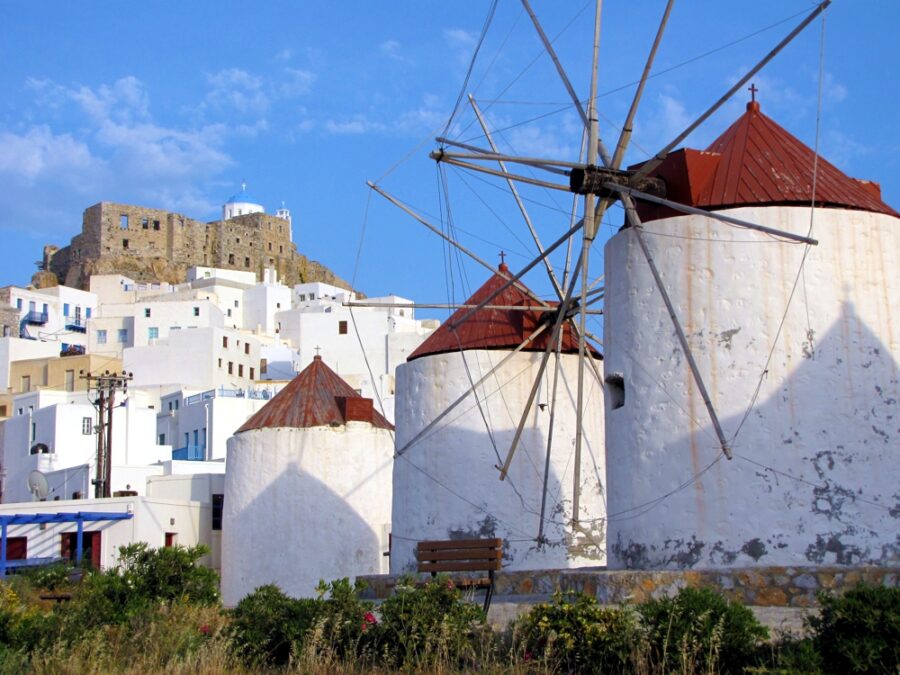
In Mykonos, those whitewashed windmills above Chora are probably the most snapped sight on the island. They’ve stood there since the 16th century, and honestly, they still feel timeless—especially at sunset.
Just a quick boat ride away, Delos is a UNESCO site where you can wander ancient ruins steeped in Greek mythology.
Ibiza’s got its own historic treasures. Dalt Vila, the fortified Old Town with its cobbled streets and Gothic cathedral, transports you back centuries. It’s also a UNESCO World Heritage site. And if you’re into natural wonders, Es Vedrà—a rocky island off the coast—is a favorite for sunset views. People say the view from those cliffs is something you don’t forget.
If you’re into guided experiences, you can easily book sightseeing tours that blend history with local culture, so you don’t have to sweat the details.
Shopping and Markets
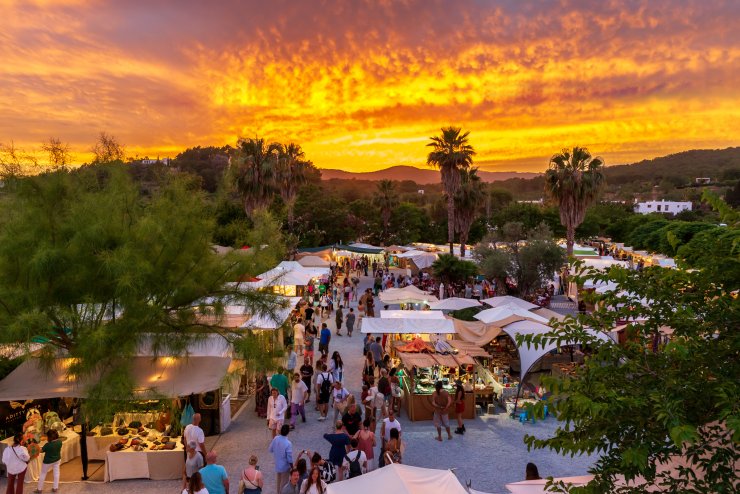
Shopping in Mykonos usually means wandering down Matoyianni Street. You’ll find boutique fashion, jewelry, and little shops packed with handmade ceramics. It’s a blend of luxury and local craft, and I’ll admit, it’s tough not to splurge.
Ibiza leans bohemian. The famous Las Dalias market in San Carlos has been buzzing since the 1950s, filled with stalls selling leather, clothes, and art. You’ll spot Adlib fashion here too—think white fabrics, loose fits, and that effortless island style.
If you’re after designer labels, Ibiza Town and Marina Botafoch have plenty of high-end boutiques. But honestly, the markets are where you’ll find those special pieces that feel like they’re just for you.
Wellness and Outdoor Adventures
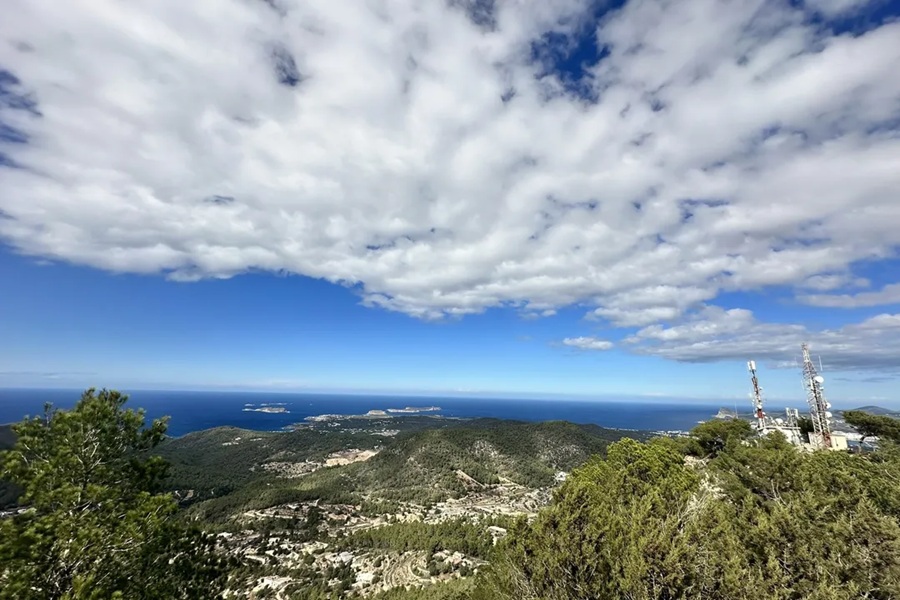
If you get restless on vacation, both islands have plenty to keep you moving. Mykonos beaches like Kalafatis are perfect for windsurfing, and the clear Aegean waters make diving a real treat. You can also hop on a boat to Delos for a mix of history and adventure.
Ibiza’s rugged landscape makes hiking a highlight. Trails up to Sa Talaia, the island’s highest point, reward you with sweeping views. The coastline hides coves you can reach by foot or kayak.
Wellness is a big thing in Ibiza now. Yoga retreats and holistic centers are scattered all over, so you can really slow down if you want. And if you prefer something organized, you can book outdoor activities like guided hikes or boat tours—just show up and enjoy.
Frequently Asked Questions
Both islands are famous for nightlife, beaches, and a taste of the high life, but the details? That’s where things get interesting. Partying, eating, relaxing, or exploring history—it all feels different depending on where you are.
What are the main differences in nightlife between Ibiza and Mykonos?
Ibiza takes the crown for nightlife. Clubs like Ushuaïa and Amnesia keep the party rolling from April to October, so you can dance for nearly half the year. The island thrives on music culture, with events every night.
Mykonos sticks to a shorter season, mostly July and August. The vibe is more polished—picture beach clubs with bottle service and DJs who drop in for a few weeks. It feels less wild, but also less spontaneous than Ibiza’s nearly nonstop scene.
Which destination, Ibiza or Mykonos, offers a more luxurious travel experience?
Both islands do luxury, but in their own way. Ibiza has big resorts and entertainment complexes where you could stay in style and never leave the property. There are also private villas tucked into quiet coves.
Mykonos leans boutique. Designer shops, chic hotels, and upscale beach clubs cater to a smaller, wealthier crowd. If you want something more curated and high-brow, Mykonos usually edges ahead.
How do the cultural attractions of Ibiza compare with those of Mykonos?
Ibiza’s Dalt Vila is a UNESCO World Heritage site, complete with fortress walls you can walk. The island’s history with salt production shaped its economy long before the party scene.
Mykonos doesn’t have as many historic sites on the island itself, but Delos is right next door—one of Greece’s most important archaeological islands. That makes it easy to pair a beach holiday with a dose of ancient history.
Can you explore Mykonos beyond its party scene?
Absolutely, and you really should. The island hides quiet villages with narrow alleys, windmills, and tiny churches that feel worlds away from the clubs. Rent a scooter and just go inland—you’ll see what I mean.
I once wandered into a family-run taverna in Ano Mera and ended up chatting with the owner for hours. That’s the kind of slow, personal experience you miss if you only stick to the beaches.
What distinguishes the beaches of Mykonos from those in Ibiza?
Ibiza stretches over 200 km of coastline and has nearly 80 beaches, from hidden coves to dramatic limestone cliffs. Some, like Las Salinas, are lively and full of music, while others are peaceful and remote.
Mykonos has fewer beaches, but they’re wider and sandier. Platys Gialos is great for families, while Psarou attracts yachts and jet-setters. The island only claims one Blue Flag beach, but honestly, the beach access and layout make them super easy to enjoy.
In terms of dining experiences, how do Ibiza and Mykonos differ?
Ibiza’s food scene? Oh, it can get expensive, especially if you wander into those buzzing tourist zones. Sure, there are loads of international restaurants, but honestly, hunting down a proper bullit de peix (that local fish stew) is totally worth your time.
Mykonos feels a bit more relaxed when it comes to eating out. You’ll stumble across cozy Greek tavernas alongside swanky waterfront spots. Sometimes you’ll snag a souvlaki for just a few euros, or maybe you’ll decide to go all out on a fancy dinner with a sea view. Everyday meals here usually cost less than in Ibiza, though club drinks might make your wallet wince, just as this comparison points out.


